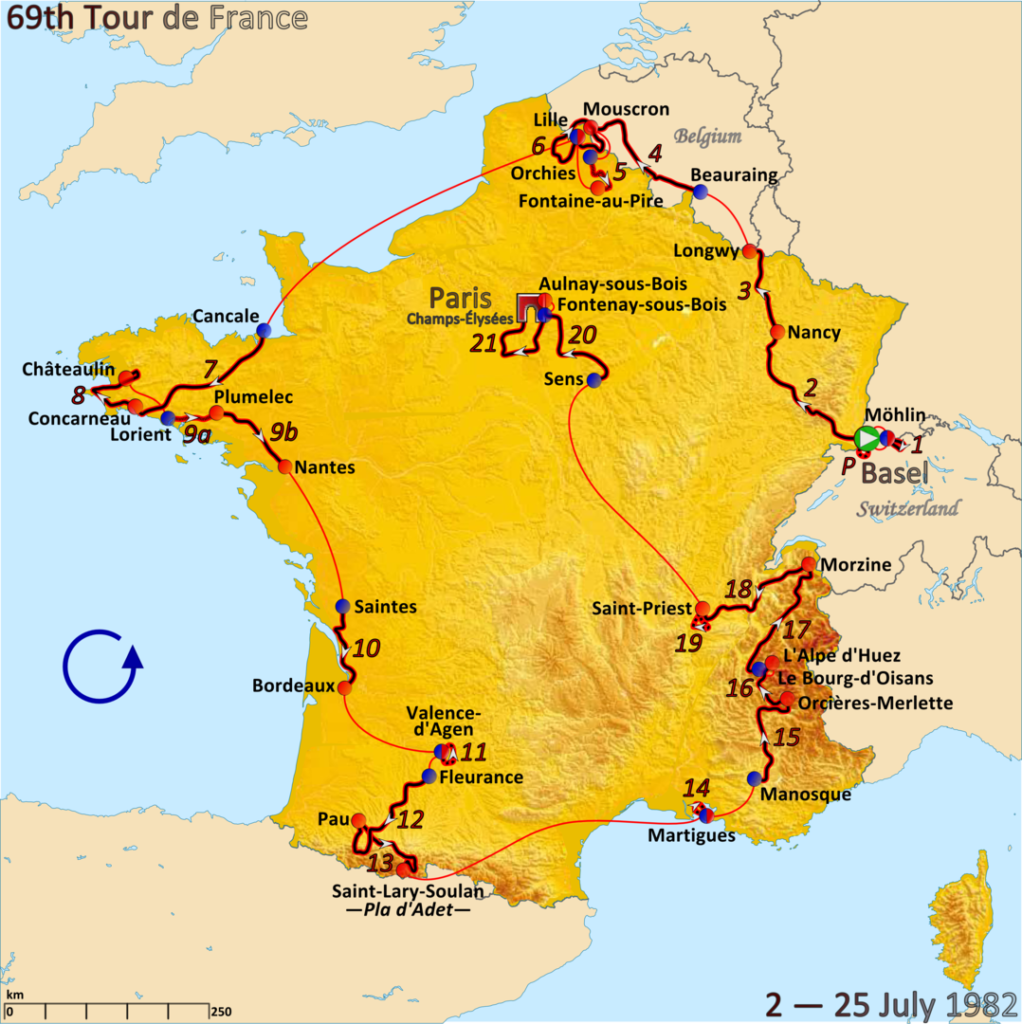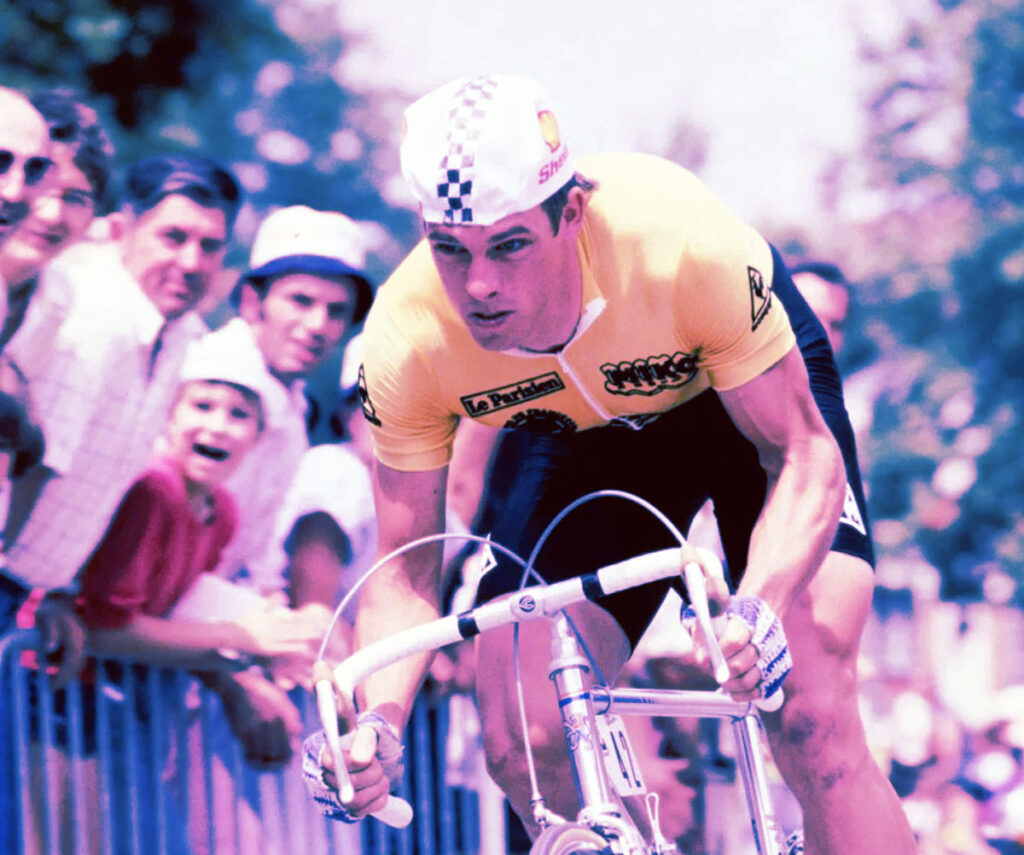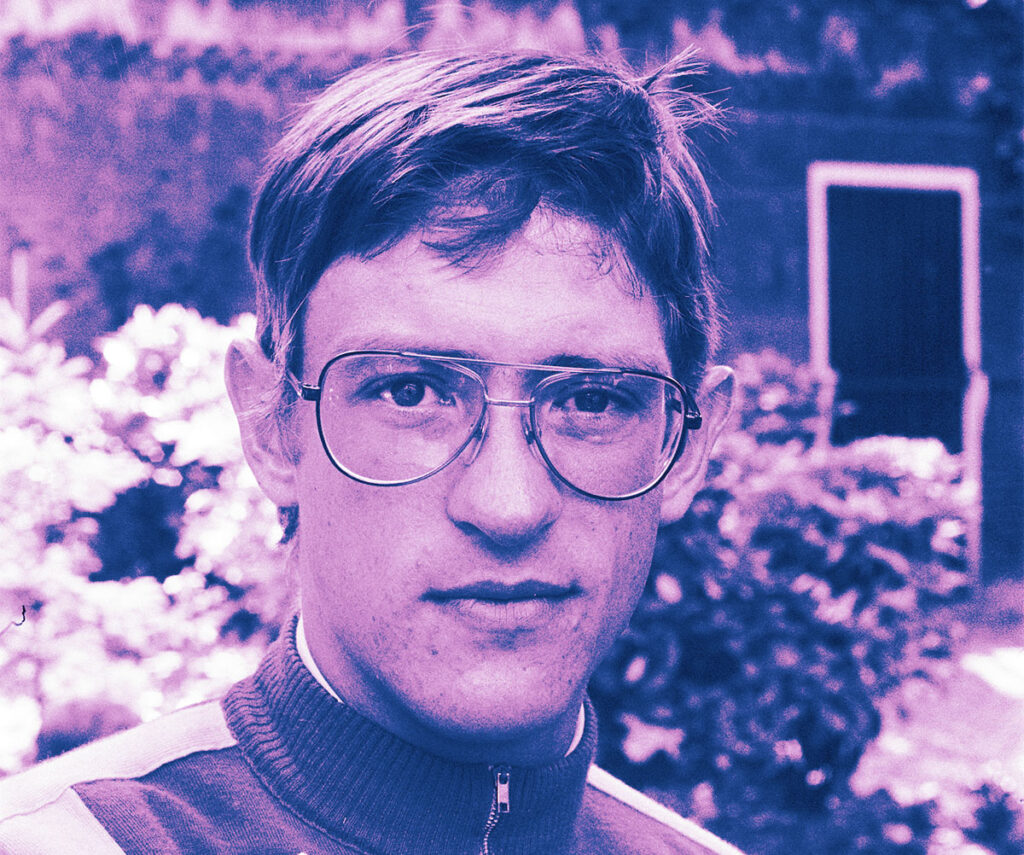
Some things never change. In 1982, the Amaury Sport Organisation was doing some of its timeless nostalgic handwringing, this time proposing that the Tour should be contested by national teams just as it was in the sport’s early days. After much consideration (aka a ten-minute conversation with their accountants), the ASO reversed course and decided to keep the lucrative sponsors on board. Seventeen teams made the startline, each bringing ten riders for a total of 170 competitors. Sensing an opportunity for global expansion, the organizers reserved a space for the American national team, but sadly the Yankee doodle dandies opted to race crits in parking lots or go skeet shooting or something instead.
Le Tour 1982
Headed into the 1982 Tour, Bernard Hinault was the clear favorite, and it wasn’t even close. Not only was he a three-time champion, he also entered the race aiming to become the fourth cyclist in history to do the Giro-Tour double following his Giro d’Italia victory earlier in the season.
Hinault didn’t appear to have much competition. The 1980 Tour winner, Joop Zootemelk, was 35 years old. The Australian Phil Anderson was drawing media attention, though the focus on him was largely due to his Anglophone status. Lucien Van Impe, the previous year’s runner-up, was not in attendance due to his team not receiving an invitation.

It was an Alps-adjacent start to the race, which departed from Basel, Switzerland, and proceeded anticlockwise around France. It quickly dipped into Belgium before jumping west into Hinault’s Brittany, headed south to the Pyrenees and then back into the Alps for a final week ascent of the Alpe d’Huez. As with the two previous 1980s Tours, the race was dominated by time-trials—four individual, and one team—though these were mostly in the back half of the race unlike previous editions. For the first time in the 1980s, the race route, length, and structure resembled that of contemporary Tours de France.
Week One: The Australian-Irish Conquest
It was a characteristic start for Hinault, and one familiar to fans and riders alike in the early 1980s: he arrived at the Prologue ready to make a statement, and dominated easily. Gerrie Knetemann finished in second place, completing the prologue results… which had become so predictable that Hinault even beat Knetemann by the exact same time margin (seven seconds) as he had in the previous year’s prologue.
Hinault’s race lead lasted just a day. Ludo Peeters soloed to victory on Stage One with a 38 second win over the peloton, led by Sean Kelly. He took over the race lead with a 14 second cushion over Hinault. Peeters would also spend only a day in yellow: Stage Two took the race over the Ballon d’Alsace, and the stage was won by Phil Anderson.

Anderson swapped his white jersey, worn since the prologue, for yellow, leading Bernard Vallet in second place by 38 seconds, and Bernard Hinault by almost a minute. In 1981, Anderson had become the first non-European to wear the yellow jersey. Now it was becoming a habit. In lieu of any other rivals of note, Anderson was beginning to be discussed as the person who could disrupt Hinault’s title defense.
Sean Kelly had taken over the green jersey after stage two, and would wear it to the end of the Tour. Stage Three, in which Kelly won the bunch sprint for third place behind stage victor Daniel Willems, and Stage Four, in which Kelly took second place behind Gerrie Knetemann, demonstrated how that green jersey victory was to play out. Between time bonuses and consistency, Kelly moved into second place overall.
Stage Five was supposed to be a team time-trial. The teams lined up and started racing, only for that most French of disruptions to occur: striking ironworkers from the Usinor steel company closed the race route, causing the stage to be canceled. A replacement team time-trial was added in on Stage Nine, reviving the split stage format that the organizers had rejected for the 1982 edition.

After an impromptu rest day, the Tour resumed with a long flat Stage Six around Lille, which finished in a sprint easily won by Jan Raas. And then a real rest day followed.
State of play as the race took a break: Phil Anderson led the GC and young riders competitions, Sean Kelly the points classification, and Bernard Vallet the mountains classification.
Rest Day One (July 4, 1982)
“Do you really want to hurt me?” – Phil Anderson to Bernard Hinault
Week Two: Taking Control
The race resumed with a sprint on Stage Seven, won by Pol Verschuere.
The following day saw an unusual Stage Eight: the organizers had planned for the 200km stage to culiminate in 15 laps of a 6km circuit. Looking for a loophole that would see him showered in glory, Régis Clère attacked early with the intent to complete the first circuit before the peloton arrived, then sit in the bunch until the finish to secure his victory. Unfortunately, we never discovered whether these are permissible tactics, since Clère punctured and suffered a mechanical, losing the entirety of his ten minute lead over the peloton. The stage finished in a sprint, won by Frank Hoste.
With the cancelation of Stage Five, Stage Nine became Stages 9a and 9b. TI-Raleigh predictably won the team time trial that started the day, but Hinault’s Renault-Elf-Gitane team put in a strong enough performance to catapult him into second place, just 28 seconds adrift of Phil Anderson. Stefan Mutter won the afternoon’s stage with a solo break a minute ahead of the peloton.
Stage Ten was also uneventful, with Pierre-Raymond Villemiane winning ahead of Sean Kelly, and nothing notable changing ahead of the individual time-trial and Pyrenees.

It was a Tour short on surprises so far, but Stage 11 offered a reprieve. Gerrie Knetemann shockingly beat Hinault in the 57.3km time-trial around Valence d’Agen, the first time he’d taken a time-trial victory over the peloton’s patron since 1979. Knetemann’s pace was so aggressive that it propelled him into second place. Hinault took over the race lead and Phil Anderson resumed wearing the white jersey, a competition he’d led since the prologue.
‘Surprises’ might have been overselling it: Hinault’s fourth Tour victory suddenly looked like a procession to Paris. Knetemann was no overall threat, third-placed Anderson was very much an outsider. The only other rider anywhere near to Hinault was 1980 winner Joop Zootemelk, who was 36 years old and almost five minutes down on GC.
If there was an opportunity for change, then Stage 12, and its ascent of the Aubisque, might bring it. Curiously, the stage was won by Sean Kelly, who arrived at the finish after sticking with the main GC contenders and climbers, securing his reputation as the best all-round cyclist in the world. Gerrie Knetemann dropped out of the top ten, leaving Hinault, Anderson, and Zootemelk as the race’s top three.

The Col d’Aspin followed the next day on Stage 13. The stage culminated with a solo win by Beat Breu, and behind him Hinault put a minute into Anderson. The race was becoming a foregone conclusion.
State of play as the race took a break: Bernard Hinault led the general classification by 3’12”, Sean Kelly the points classification, Bernard Vallet the mountains classification, and Phil Anderson the young riders classification. And, frankly, none of these looked likely to change.
Rest Day Two (July 13, 1982)
Joan Jett later went on to star in the Mighty Boosh and host Great British Bake Off.
Week Three: Bore de France
The race resumed with a Stage 14 time-trial, and any hopes that Hinault would falter were immediately dashed. He won comfortably, and now led his closest rival by over five minutes. Next up: the Alps.
Pascal Simon won Stage 15 to Orcières-Merlette. Behind him, Hinault put almost three minutes into Phil Anderson, now leading Zootemelk by 5’26” and Andeson by 7’57”.
The Alpe d’Huez followed on Stage 16. Stage 13’s winner, Beat Breu won again, and Hinault crossed the line alongside Joop Zootemelk and 1981’s Alpe winner, Peter Winnen. Anderson dropped to seventh place, more than ten minutes behind Hinault.

Winnen continued his good form to win Stage 17 and move up to third place overall while Hinault marked Zootemelk closely. Bernard Vallet suffered and dropped out of the top ten but had secured enough mountains points that he would win the polka dot jersey so long as he made it to Paris. A solo breakaway gave Adri van Houwelingen a win with a huge margin on the transitional Stage 18.
And so to the end game. Stage 19 was the race’s final time-trial. Hinault, of course, won. Wrapping up the results, the top five (Hinault, Zootemelk, van der Velde, Winnen, Anderson) was finalized. Just two stages remained, both flat. Murmurs were beginning though. Hinault had made this race boring.
Those voices got louder. After the Stage 20 sprint finish, won by Daniel Willems, fans and press reflected on the Tour and accused Hinault of riding a boring race. He was winning effortlessly but losing the fans in doing so.
Whether it’s bike racing, throwing protestors off of podiums, or blowing up badgers with dynamite, Bernard Hinault only responds to obstacles in one way: aggression. In one of the most iconic moments in Tour de France history, he hit the front of the peloton on its final circuits of the Champs Elysees (Stage 21) and overpowered the sprinters to take one final, definitive stage victory. Yeah, that’ll teach people to complain that you’re too dominant.

He may have won by larger margins in the past, but the 1982 Tour was the most assured and comfortable of Hinault’s career. In fact, much of the race had been settled early: Phil Anderson led the white jersey standings from the prologue all the way to the Champs Elysees, Sean Kelly had worn the green jersey since stage two, and Bernard Vallet had led the mountains classification since stage one. There was no shortage of quality in the 1982 race, but feelings of excitement and suspense had been very much absent.
Bernard Hinault had now won four Tours de France, and joined Fausto Coppi, Jacques Anquetil, and Eddy Merckx as a rare winner of the Giro-Tour double. The next year, he could equal the record for Tour victories… or could he? The Tour’s organizers had been paying attention to another sporting event that summer, the FIFA World Cup in Spain. It had received incredible viewing figures and the Tour was eager to get a slice of that pie. After some consideration, they proposed moving to a four year schedule in order to achieve those viewing figures—a simply baffling conclusion. Would the 1983 Tour happen at all?
Final Results
General Classification
Points Classification
| 1 | Sean Kelly (IRE) | Sem–France Loire–Campagnolo | 429 |
|---|---|---|---|
| 2 | Bernard Hinault (FRA) | Renault–Elf–Gitane | 152 |
| 3 | Phil Anderson (AUS) | Peugeot–Shell–Michelin | 149 |
Mountains Classification

